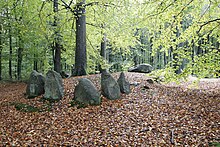Blommeschobbel
The Blommeskobbel is a small beech forest and is located about four kilometers southeast of Fynshav , on the Little Belt , on the east coast of the Danish island of Alsen .
Langdysser 1 + 2
In the northern part of the forest two broad hunebeds are of 53 and 34 meters in length, side by side, in two there are two Dolmen that v to 3500th Were built from boulders by the carriers of the funnel beaker culture (TBK) . The larger megalithic bed has 69 curbs. Three of the four chambers, which are evenly distributed over the length, have large cap stones. The largest weighs over 20 tons and is one of the largest in Denmark.
There are two circular drives in the immediate vicinity of the large Langdysser.
Runddysse 1
The small round hill immediately southeast of Langdysse 2 is 0.6 m high and 8 m in diameter. It is framed by 17 small curbs. The 0.6 × 1.4 m chamber of the dolmen consists of three supporting stones and a threshold stone . The triangular capstone has sides of 1 × 1.7 × 1.7 m and is 0.6 m thick. The chamber has grown into a large tree.
Runddysse 2
The slightly distant oval hill is about 1.5 meters high and measures 16 × 11 m. It is framed by 18 curbs. The 1.7 × 1.0 m measuring chamber in the middle of the hill consists of two supporting stones on each side and an end stone. The two eastern ones are split. The height under the capstone is about 1.0 m. The chamber floor is covered with a 5–8 cm thick layer of burned flint .
During the restoration 1935-36 the chambers have been excavated, but only a flint dagger and a zerscherbtes found clay pot, a re-use at the end of the Neolithic evidence.
Nearby is the Dobbeltdysse of Oleskobbel .
See also
literature
- Ingrid Falktoft Anderson: Vejviser til Danmarks oldtid . 1994, ISBN 87-89531-10-8 , pp. 76-77
- Peter V. Glob : prehistoric monuments of Denmark. Wachholtz, Neumünster 1968, p. 48
- Karsten Kjer Michaelsen: Politics bog om Danmarks oldtid . Copenhagen 2002 ISBN 87-567-6458-8 , p. 134
Web links
Remarks
- ↑ Is the name commonly used in Denmark for dolmens lying in a barren bed. In contrast, dolmens in a round hill are called round dyssers.
Coordinates: 54 ° 57 ′ 15.7 ″ N , 10 ° 0 ′ 55.6 ″ E
